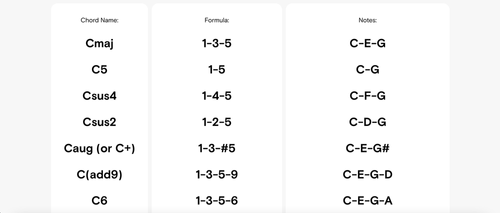
Understanding Chord Symbols and Alterations + Cheat Sheets!
C#7b5b9#11b13??!
Have you ever found yourself struggling to read those perplexing chord symbols and alterations in your sheet music or chord charts? We want to help you! Whether you're a solo musician or a part of your worship team, understanding these elements is crucial to gaining more confidence and elevating your sound.
So, let's dive in to chord symbols and alterations together!
But first… Cheat Sheets!
We just launched our brand new chord symbols and alterations cheat sheets in all keys! So if you want to skip this blog post and jump straight to the cheat sheets, click the button to head there now! If not, keep reading below.

Understanding the Different Types of Chords
At the heart of sheet music and lead sheets, chord symbols act as a musical shorthand, providing a compact way to convey harmonic information. They consist of letter names (e.g. C, G7, Dm) representing the root notes of chords, combined with additional symbols and numbers that modify their qualities and voicings. Chord symbols serve as a roadmap, guiding you through the harmonies and chord progressions of a song. They are incredibly important to know if you are playing on worship teams, as they help create rich, colorful arrangements and ensure synchronicity throughout your ensemble. There are 8 different types of chords, each with their own unique structure, function, and notation. Click below to learn more:
3-part chords
4-part chords
ⓘ For more info on using these chords in different key signatures,
check out our major key cheat sheets here.
What are Chord Alterations?
Chord alterations are additions or modifications made to basic chords and 7th chords that introduce unique tonal colors and tensions. They add flavor and character to the harmonies, transforming simple progressions into captivating timbres and sounds.
Alterations are always notated immediately after the chord name (ex. C7), and are indicated by symbols, accidentals, and/or numbers (Ex. C7b9).
Chord Alteration Symbols
What are Slash Chords?
C/E?
Slash chords, also known as split chords, provide additional clarity when specific bass notes or inversions are desired. They are written with a chord symbol followed by a slash ("/") and a note name indicating the desired bass note. For example, C/E represents a C major chord with E in the bass. Slash chords are particularly useful for band musicians who read lead sheets, as they allow for more precise accompaniment and chord voicings. In a solo instrument context, the player performs both the chord and bass note simultaneously.
The Ultimate Guide to Chord Alterations in All Keys
Congratulations! Now that you understand the building blocks of chords, symbols, and alterations, now it’s time to bring it all together and head on over to our cheat sheets!